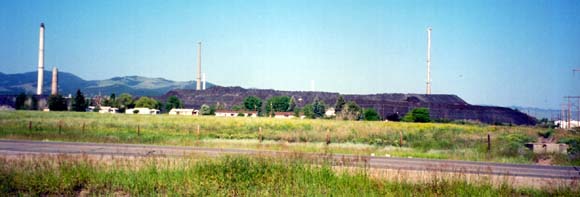|
Slag piled high
in East
Helena 
If you've traveled through East Helena,
you probably noticed the huge pile of black
material at the ASARCO Smelter along the
highway. The material, called
"slag", is waste product produced as ASARCO
removed lead from the ore.
Getting the lead out . . .
For more
than a century, crushed ores
containing galena (PbS) were brought to East
Helena from as far away as Chile and Korea.
Once at the smelter, the ores were "roasted"
in order to remove the sulfur. The sulfur combined with oxygen to form a gas called sulfur dioxide, a pollutant that contributes to acid rain. A law called the Clean Air Act, which went into effect in the early 1970s, required that industries like the smelter remove this emission. A pollution-control device called a "scrubber" had to be installed to do this. The roasting
formed a material called "sinter," which was a
mixture of lead oxide (PbO) and other rock
materials. Next
the sinter had to be melted. Crushed
limestone and quartz were added to make it
easier to melt the mixture. Once the material
was melted, the heaviest stuff (lead) would
sink to the bottom of the tank. The molten
lead was then drained out through openings
in the bottom into molds where it
solidified.
Separation by melting . . .
This
separation by melting is called
smelting. The rest of the molten material,
which had been floating above the layer of
lead,
also solidified, forming the black waste
product called slag. For years the slag was
disposed of by dumping it along the
edge of the smelter property.
Other metals too . . .
Until its
closure in the spring of 2001, the
ASARCO Smelter shipped 10-ton pieces of
lead by rail to a refinery back east. The
refinery was able to separate trace amounts of
other valuable metals such as gold and silver.
In a typical year (early 1990s) the smelter's
bullion yielded the following:
69,000 tons of lead
3,500 tons of copper
690 tons of arsenic
150 tons of
bismuth
20,000,000 oz. of
silver
200,000 oz. of
gold Anaconda also
has piles of slag . . .
The smelter in
Anaconda was designed to extract copper
from the ores mined in Butte. The texture of
Anaconda's slag (CLICK HERE to see aerial photo.) is much different than the
slag in East Helena. East Helena's slag is
very "blocky," with pieces varying from
fist-size to much larger. In Anaconda the
slag is more like sand because the molten
slag was spilled into water, causing it to
harden and shatter into sand-sized pieces. In
fact Anaconda's slag has been used in sand
traps at the famous Old Works Golf
Course.
Trivia . . .
Country Music Hall of Fame singer, Charlie Pride, once worked at East Helena's smelter and starred on the Smelterite baseball team.
Below: A closer view of
the slag (looking toward Helena)
Below: A view from
the south (looking over the Helena
Valley) 
Terms: ore, flux
| 






